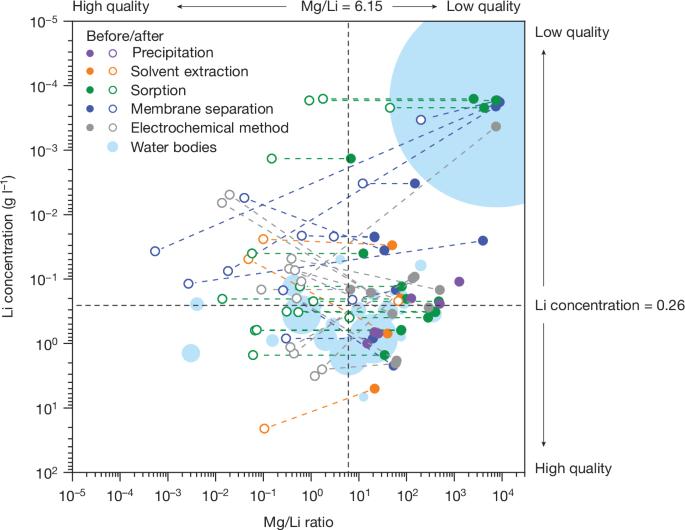从低质量盐水中提取锂
IF 48.5
1区 综合性期刊
Q1 MULTIDISCIPLINARY SCIENCES
引用次数: 0
摘要
在追求环境可持续性的过程中,对电动汽车和可再生能源技术不断增长的需求大大增加了对高效锂提取方法的需求。传统的锂生产依赖于地理上集中的硬岩矿石和盐碱水,这伴随着大量的能源消耗、温室气体排放、地下水枯竭和土地干扰,从而带来了显著的环境和供应链挑战。另一方面,沉积水体、地热流体、油田采出水、海水以及部分咸水和盐湖中的低质量卤水储量丰富,地理分布广泛,潜力巨大。然而,由于低锂浓度和高镁锂比,从这些资源中提取锂存在技术挑战。本文综述了锂提取技术的最新进展和面临的挑战,包括沉淀法、溶剂萃取法、吸附法、膜分离法和电化学分离法。此外,在分离过程的基本原理框架内,我们分享了对锂提取技术未来发展的看法。其目的是鼓励发展能够利用低质量盐水的巨大潜力的创新提取方法。本文章由计算机程序翻译,如有差异,请以英文原文为准。


Lithium extraction from low-quality brines
In the quest for environmental sustainability, the rising demand for electric vehicles and renewable energy technologies has substantially increased the need for efficient lithium extraction methods. Traditional lithium production, relying on geographically concentrated hard-rock ores and salar brines, is associated with considerable energy consumption, greenhouse gas emissions, groundwater depletion and land disturbance, thereby posing notable environmental and supply chain challenges. On the other hand, low-quality brines—such as those found in sedimentary waters, geothermal fluids, oilfield-produced waters, seawater and some salar brines and salt lakes—hold large potential owing to their extensive reserves and widespread geographical distribution. However, extracting lithium from these sources presents technical challenges owing to low lithium concentrations and high magnesium-to-lithium ratios. This Review explores the latest advances and continuing challenges in lithium extraction from these demanding yet promising sources, covering a variety of methods, including precipitation, solvent extraction, sorption, membrane-based separation and electrochemical-based separation. Furthermore, we share perspectives on the future development of lithium extraction technologies, framed within the basic principles of separation processes. The aim is to encourage the development of innovative extraction methods capable of making use of the substantial potential of low-quality brines. Precipitation, solvent extraction, sorption, membrane-based separation and electrochemical-based separation are described as promising methods for extracting lithium from low-quality brines, which have extensive reserves and widespread geographical distributions.
求助全文
通过发布文献求助,成功后即可免费获取论文全文。
去求助
来源期刊

Nature
综合性期刊-综合性期刊
CiteScore
90.00
自引率
1.20%
发文量
3652
审稿时长
3 months
期刊介绍:
Nature is a prestigious international journal that publishes peer-reviewed research in various scientific and technological fields. The selection of articles is based on criteria such as originality, importance, interdisciplinary relevance, timeliness, accessibility, elegance, and surprising conclusions. In addition to showcasing significant scientific advances, Nature delivers rapid, authoritative, insightful news, and interpretation of current and upcoming trends impacting science, scientists, and the broader public. The journal serves a dual purpose: firstly, to promptly share noteworthy scientific advances and foster discussions among scientists, and secondly, to ensure the swift dissemination of scientific results globally, emphasizing their significance for knowledge, culture, and daily life.
 求助内容:
求助内容: 应助结果提醒方式:
应助结果提醒方式:


